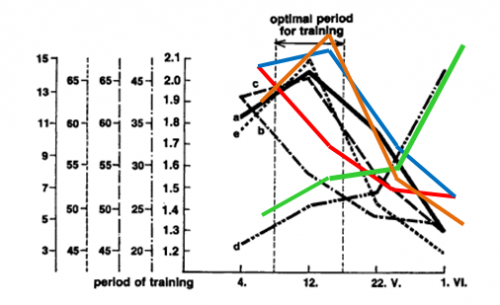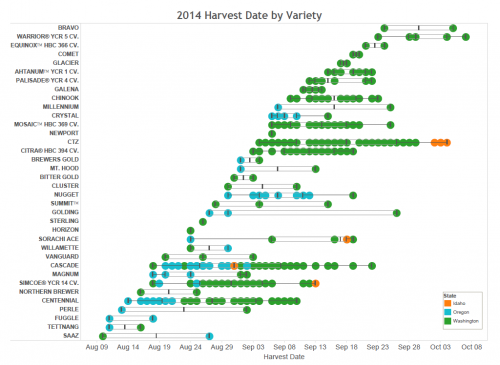Training hops: Part 1
Properly timing bine training in the spring is crucial for obtaining maximum hop yields and varies by variety and location.

While there are many important best management practices involved in the production of hops, one of the most crucial is training date. In the spring, hops emerge from dormancy and can be chemically pruned to encourage strong, succulent secondary shoot growth and reduce disease. Because bines take three to four weeks to regrow after pruning before they are ready for training, the timing of pruning is also critical. If hops have not been pruned by May 1, as a result of cool spring weather, pruning should be skipped for that growing season. Based on several growing seasons in Michigan, hops should be trained by June 1. Baby hops should not be pruned.
Training involves wrapping three-four bines in a clockwise direction around each string to encourage growth. The timing of training (and pruning) is critical for obtaining maximum hop yields. In a Czechoslovakian study, researchers measured several factors related to hop yield and quality over different training dates. (Figure 2). Hops that were trained earlier than the optimum window had somewhat reduced yields, and hops that were trained too late, had a nearly 40 percent reduction in hop yields. These data suggest that growers are better off erring on the side of training too early versus too late.

Figure 2. Effect of training date (May 4 – June 1) on hop plant structure and cone yield. A- yield (kg) of fresh hop per plant, b- length of cones in mm, c- number of shoots, d- setting density (number of cones per 10 cm of shoot), e- mean length of shoots (cm). Source: RybaCek, V. 1991. Hop Production. Developments in Crop Science 16. Pg. 205
Determining the optimum training date is difficult since the date can vary quite widely by variety. For example, in the Pacific Northwest (PNW) training date varies from the beginning of May through the third week of May depending upon the variety (Table 1).
|
Table 1. Typical hop variety, pruning and training dates in the Yakima Valley, Washington. | ||
|---|---|---|
|
Variety |
Pruning Dates |
Training Dates |
|
Willamette |
4/12 |
5-1 / 5-3 |
|
Cascade |
4/12 |
5-4 / 5-7 |
|
Cluster |
4/17 |
5-7 / 5-8 |
|
Millenium |
4/18 |
5/10 |
|
Citra |
4-18 / 4-26 |
5-10 / 5-15 |
|
Eqinox |
4/26 |
5-16 / 5-17 |
|
Mosaic |
4-26 / 4-28 |
5-15 / 5-20 |
|
Zeus |
4-28 / 4-30 |
5-19 / 5-20 |
|
Topaz |
4/30 |
5/20 |
Source: John I. Haas.
Because we have a compressed growing season in relation to the PNW, optimum training dates in Michigan will likely differ. How is a grower in Michigan supposed to determine the optimum training date? While no growing degree day or latitude or day length models have been developed to assist with training time, likely the best method is to work backward from typical harvest dates. Most early harvested varieties will yield highest if trained early and most late harvested varieties if trained later (Figure 3). However, this is not always the case for every variety and can vary by growing season.

Figure 3. Hop harvest date by cultivar in Washington State, Oregon, and Idaho. Source: Zac German, Yakima Chief-Hop Union, LLC. Great Lakes Hop and Barley Conference, Grand Rapids, Michigan. April 11, 2015.
The best bet for growers outside of the PNW is to experiment with training dates based on anticipated harvest dates. It is recommended to keep detailed records of day length, growing degree days, pruning dates, training dates, and yields. To determine accurate growing degree days, visit the MSU Enviroweather website to access data from the weather station closest to your location. It will likely take a few years of trial and error for growers to determine optimum training dates.
The next article in this series will talk about how you can avoid bull shoots to maximize yields. For more information from Michigan State University Extension on hops please visit our website.



 Print
Print Email
Email



